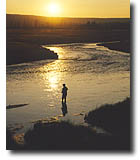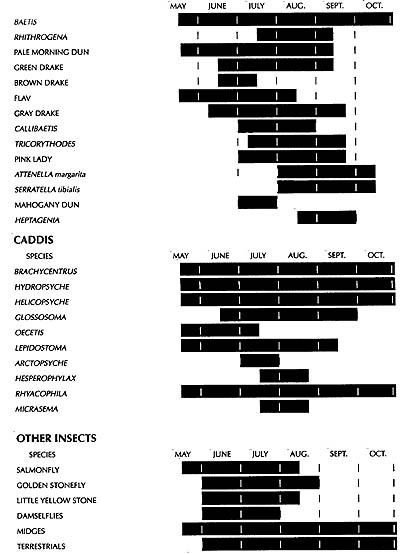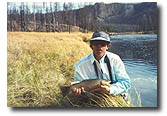%20of%20flyfishingbar.JPG)
Fly - Fishing Yellowstone
Waters
There are over a hundred lakes and a
thousand miles of streams in Yellowstone National Park; nowhere in the
world are so many public rivers and streams found in such a condensed
area. Seven varieties of gamefish live in Yellowstone: cutthroat,
rainbow, brown, brook, and lake trout, along with grayling and mountain
whitefish. Only cutthroats, grayling, and mountain whitefish are native
to the Park.
In the 1890s, any lake, stream, pond,
river, or slough that held water was stocked with fish. Little was known
then about fisheries management; many of these places could not support
self-sustaining populations and returned to their former barren state.
Those that could support fish retain wild populations to this day. The
last fish were stocked in Yellowstone in the mid-1950s.
The Park is divided into four sections
by a network of roads called the Loop Roads.
1. Northwest: West Entrance (West Yellowstone, Montana)-Madison Junction-Norris
Junction-Canyon Junction-Tower Junction- Mammoth-North Entrance (Gardiner, Montana).
2. Northeast: East Entrance-Fishing Bridge-Canyon Junction- Tower Junction-Mammoth-North
Entrance (Gardiner, Montana). Cody, Wyoming, is one hour east
of YNP's East Entrance.
3. Southeast: South Entrance-West Thumb-Fishing Bridge-East Entrance. Jackson, Wyoming, is one hour south of YNP's South Entrance.
4. Southwest: South Entrance-West Thumb-Canyon Junction- Norris Junction-Madison
Junction-West Entrance (West Yellowstone, Montana).
This Yellowstone Flyfishing directory
is divided into the same four sections. Each begins with an overview
of the area. The major rivers and lakes are discussed in detail. - The Fly Fishing Directory is from the informative
book, Yellowstone
Fly-Fishing Guide by Craig
Mathews and Clayton Molinero.
Be sure to visit the Flyfishing
Guide Service page with information on guide service for Yellowstone
National Park.
 The
first river to clear from snowmelt is the Firehole; it's often The
first river to clear from snowmelt is the Firehole; it's often
the only game in the Park on the opener, and each May a group
of Firehole River regulars eagerly awaits the Memorial Day weekend.
The Firehole usually offers great dry-fly fishing during afternoon mayfly
hatches and continues to do so until the end of June. By the second
week of June, the Gibbon and Madison Rivers drop and clear, the ice
comes off Yellowstone Lake, and the fishing season is under way for
other waters. One by one the Parks rivers run clear of snowmelt, and
most become fishable by July 4. Usually, the last rivers to clear are
the Yellowstone and Lamar in early July.
There is no "best" time to
fish Yellowstone Park. Each month of the short season offers its own
style of best fishing. From the season opener in late May through the
end of June, the best places to fish are the Firehole, Gibbon, Madison,
and Lewis Rivers, and both Yellowstone and Trout Lakes, when they open
on June 1st.
In July, all waters become fishable in
the Park, including the small streams. Insect hatches are at their peak
in July, and this is a favorite time for dry-fly fishers. The Firehole
and Madison Rivers are two exceptions, however, because a combination
of thermal water and summer heat raises their water temperatures into
the 80s. Fishing is slow on these two rivers until water temperatures
drop in early September. July and August are our fair-weather months,
with the most consistent hatches and favorable stream conditions.
August is the best time for lake fishing
in the Park. This is a great time to fish the backcountry lakes in Yellowstone,
as the mosquitoes and biting flies thin. All rivers except the Firehole
and Madison continue to fish well through the month. As the aquatic
insect emergences wane, terrestrials play an increasingly important
role in the trout diet. Imitations of grasshoppers, ants, crickets,
and beetles are a mainstay in the angler's arsenal until the end of
the season.
During the late season, September and
October, only a few hatches remain. The big Green Drakes appear on the
Lamar River and Slough Creek, along with tiny Blue-Winged Olives and
midges. The Firehole and Madison Rivers become fishable again and produce
excellent hatches of BWOs and midges. October is the best month to come
if you want to catch the large migrating fish in the Madison and Lewis
Rivers. As spawning time approaches and the weather becomes more
winterlike, these big trout become aggressive and territorial, attacking
baitfish imitations and other large streamer flies.
HATCHES___________________________________________________
Whenever possible we refer to insects
by their common names. When no common name is available, we use an insect's
scientific name.
In the accompanying chart you'll find
an overall emergence table that will give you an idea when to expect
various insects throughout the Park. In the chapters to come, major
lakes and rivers where hatches are important are also accompanied by
specific emergence tables. Below is some broadly useful information
about insect activity in the park.

BEAR COUNTRY____________________________________________
Yellowstone is bear country,
and there is no guarantee of your safety. Bears often utilize trails,
streams, and lakeshores. Entry into some areas may be restricted; check
with a ranger for specific bear management information. Traveling alone
in bear country is not recommended. Make enough noise to make your presence
known to bears. If you should encounter a bear, give it plenty of room,
detour if possible, or wait for the bear to move on. If a bear should
charge or attack and the situation allows, climb a tree. If you are
caught by a bear, try playing dead. Do not run; this may excite the
bear. Carefully read all bear country guidelines and regulations and
be prepared for any situation. From Fishing Regulations for Yellowstone
National Park
WHAT TO BRING____________________________________________
 Each
gate community offers a selection of fly shops and guide services. Make
it a point to check with these local experts regarding current stream
conditions and hatches. First-time visitors should spend a day or two
with a knowledgeable guide; this can save you a lot of gas and boot
leather. Each
gate community offers a selection of fly shops and guide services. Make
it a point to check with these local experts regarding current stream
conditions and hatches. First-time visitors should spend a day or two
with a knowledgeable guide; this can save you a lot of gas and boot
leather.
We recommend an 8 - 9-foot
rod balanced for a 4- to 6-weight line. A floating weight-forward or
double-taper line will handle most situations. Full-sinking lines are
helpful on lakes, and sink-tip lines are often used when fishing streamers
or big nymphs in the fall.
Felt-soled,
chest-high waders are the choice of most Yellowstone anglers. Lightweight
waders made of Gore-Tex or microfibers are convenient for packing along on backcountry trips.
Neoprene waders are required in colder weather, especially when tubing
lakes or fishing in the fall.
Never go fishing in Yellowstone
without rain gear, sunscreen, sunglasses, bug dope, and a hat. Backcountry
users may want to have a can of bear repellent (pepper spray) handy
and hang bells on their packs. Although we single out bears, all animals in the Park are wild and should be given a wide berth and proper
respect. We have seen more visitors put up trees by elk, bison, and
moose than by all the bears combined.
Yellowstone's lakes and ponds remain an untapped resource and largely unexplored,
visited by only a handful of Yellowstone regulars. It's a mystery why
so many anglers are reluctant to give lake fishing a try.
Yellowstone's stillwaters offer solitude,
a pleasant change of pace from the sometimes crowded rivers, and a chance
to see the Park as few others do. The lakes feature fishing for all
trout species, and they provide your best opportunity to land a trophy
trout or one of the seldom-seen grayling. The lakes have periods of
fine dry-fly fishing to emerging insects. When insects aren't hatching,
there's great fishing with subsurface flies. Each season we seem to
spend more and more time exploring the lakes of Yellowstone. Remember
that if you're bringing in a boat or float tube, you'll need a permit
for your watercraft as well as a fishing permit.
Yellowstone National Park is managed
as a natural area to protect plants, wildlife, geology, and scenery.
Angling has been a major visitor activity for over a century. Present
regulations reflect the park's primary purposes of resource protection
and visitor use. The objectives of the fishing program are to:
- Manage aquatic resources as an important
part of the ecosystem.
- Preserve and restore native fishes
and their habitats.
- Provide recreational fishing opportunities
for the enjoyment of park visitors, consistent with the first two
objectives.
In Yellowstone, bald eagles, ospreys,
pelicans, otters, grizzly bears, and other wildlife take precedence
over humans in utilizing fish as food. None of the fish in Yellowstone
are stocked, and populations depend on sufficient number of spawning
adults to maintian natural reproduction and genetic diversity. In Yellowstone
National Park, we place less emphasis upon providing fishing for human
consumption and put more emphasis upon the quality for recreational
fishing. Anglers, in return, have the opportunity to fish for wild trout
in a natural setting.
Because of the increasing number of anglers
in the park, more restrictive regulations have been adopted in Yellowstone.
These restrictions include: season opening/closing dates, restrictive
use of bait, catch-and-release only areas, and number/size limits according
to species. A few places are closed to the public to protect threatened
and endangered species, sensitive nesting birds, and to provide scenic
viewing areas for visitors seeking undisturbed wildlife.
Permits and Fees
A permit is required to fish in Yellowstone.
Anglers 16 years of age and older are required to purchase either a
$10 ten-day or $20 season permit. Anglers 12 to 15 years of age are
required to obtain a non-fee permit. Children 11 years of age or younger
may fish without a permit when supervised by an adult. The adult is
responsible for the child's actions. Fishing permits are available at
all ranger stations, visitor centers, and Hamilton General Stores. No
state fishing license is required in Yellowstone National Park.
Non-toxic Fishing
Yellowstone National Park has implemented
a non-toxic fishing program. Nationwide, over three million waterfowl
die from lead poisoning through ingestion. Because lead from fishing
tackle concentrates in aquatic environments, tackle such as leaded split
shot sinkers, weighted jigs, and soft weighted ribbon for fly fishing
are prohibited. Only non-toxic alternatives to lead are allowed.
General
Fishing Regulations
1. Fishing Permits and General Fishing
Season
a. Fishing Permits:
Anyone 12 years of age or older must have a valid Yellowstone National
Park fishing permit to fish in the park. A fishing permit is valid
only if signed by the permittee. A permit fee is charged for anyone
16 years of age or older. Children 11 years of age or younger may
fish without a permit when supervised by an adult. The adult
is responsible for the child's actions.
b. Park Rangers may check permits,
inspect tackle and fish, and inspect creels and/or other containers
where fish tackle may be stored.
c. General Fishing Season in Yellowstone National Park is open each day from 5 am to 10 pm,
beginning on the Saturday of Memorial Day weekend through and including
the first Sunday in November. There are several area-specific
exceptions to the general opening dates.
2. General Tackle and Bait Restrictions
a. Each angler may
use only one rod or line, which must be held in hand.
b. Only artificial lures and
flies may be used. No natural or organic bait such as salmon
eggs, worms, insects, or foodstuffs is allowed. Scented attractants
are illegal.
c. Lures may have only one
hook. The hook may have a single, double or treble configuration.
No fish snagging is allowed.
d. Flies may have only one
hook with a single point. Up to two flies may be used on a single
leader.
e. Leaded fishing tackle such as leaded split-shot sinkers, weighted jigs (lead molded to a
hook), and soft lead-weighted ribbon for nymph fishing are not allowed.
3. General Size and Possession Limits
a. Size and possession
limits vary by species and area. The maximum number of fish an angler
can keep is five per day (not counting lake trout from Yellowstone
or Heart Lakes, or brook trout from Pocket Lake) of which at least
three must be brook trout. An angler must cease fishing immediately
after filling his/her possession limit except on Yellowstone Lake.
Possession limits include all fish, whether fresh, stored in freezer/ice
chests or otherwise preserved.
b. Fish that do not meet the
specified size restrictions must be returned carefully and
immediately to the waters from which they were taken. Unintentionally
killed fish should also be returned to the water so that they can
be consumed by wildlife. It is the responsibility of the angler
to be able to measure fish lengths and to identify fish by species.
4. General Closures: No
fishing from any road bridge or boat dock.
5. Boat and Float Tube Regulations: A Boat Permit is required of all types of vessels. (Float
tubes are classified as vessels. They are not allowed on any river or
stream in Yellowstone except the Lewis River between Lewis and Shoshone
Lakes.) Boat Permits must be obtained in person at any of the
following locations: South Entrance, Lewis Lake Campground, Grant Village
Backcountry Office, Bridge Bay Marina and Lake Ranger Station. Non-motorized
permits only may be obtained at Mammoth Backcountry Office, Canyon Backcountry
Office, Northeast Entrance, and Bechler Ranger Station. Fees are charged
for both motorized and non-motorized boat permits
|

